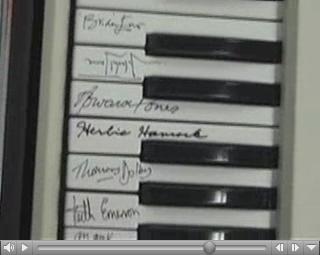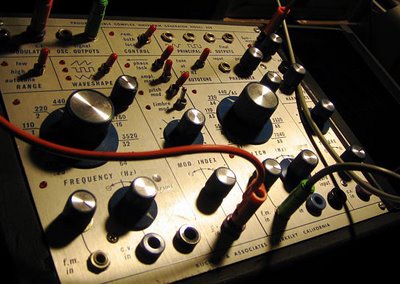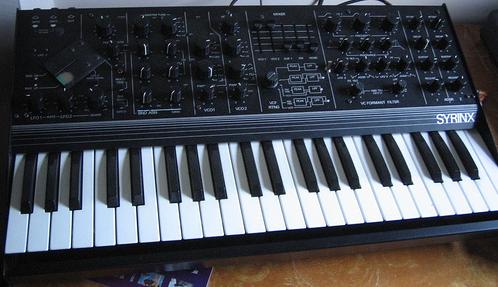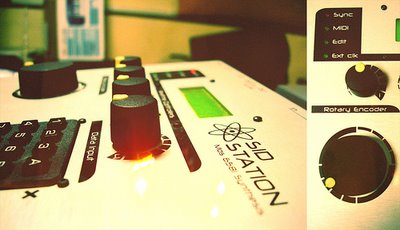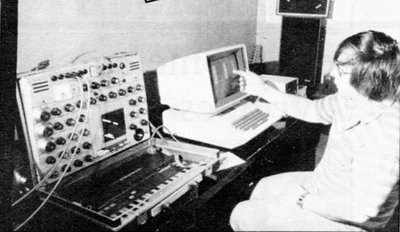 It's a synth one. Title link takes you there.
It's a synth one. Title link takes you there.
Friday, April 28, 2006
New Waldorf Products to be Announced Winter NAMM 2007

Click here for a Google translated interview of Joachim Flor of Waldorf. Replace "Whale Village" with "Waldorf" when you get there. : ) Here's a link to the original in German. This one sent my way via Dr. Georg Müller.
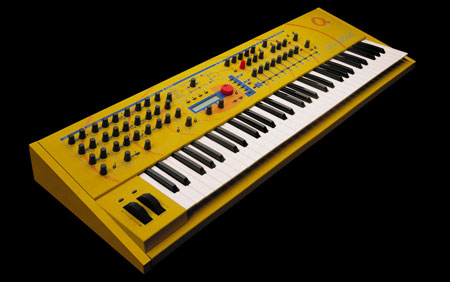 "AMAZONA.de:
"AMAZONA.de:What might we expect from the new Waldorf?
JOACHIM FLOR:
Of course there will be new Waldorf products... the future developments will be characterised by innovation, unmistakable sound, optimal ergonomics, excellent design, user friendliness and all that the name Waldorf stood for, stands and will continue to stand. But we'll let you be surprised. Our first goal is the winters NAMM 2007 in Anaheim!"
I can't wait. Something tells me Winter NAMM 2007 will be the most hyped NAMM in a long, long time. : ) Thanks for sending this one in Georg!
Update via Mr. Array in the comments:
"Wheee!
Here is another message, this time from Stefan Stenzel where he more or less confirms that there will be paid OS updates for legacy Waldorf products:
http://lists.waldorf.synth.net/pipermail/user-forum/2006-April/004774.html"
"Since we are not a legal successor of the preceeding waldorf companies,
we cannot provide further upgrades for free. However, rest assured that
the price we will charge for future upgrades will be reasonable."
Andromeda A6 Pads and Strings
 Tomislav Babic sent the following samples to AH. I asked him if I could put up a post on them and he said yes. Here there are. Enjoy. Title link takes you to Tomislave Babic's website.
Tomislav Babic sent the following samples to AH. I asked him if I could put up a post on them and he said yes. Here there are. Enjoy. Title link takes you to Tomislave Babic's website.http://www.babic.com/SYN/A6/clc_A6-BerlinPad.mp3
http://www.babic.com/SYN/A6/clc_A6-MeltsInYourMouth.mp3
http://www.babic.com/SYN/A6/clc_A6-NotchPWMPad.mp3
http://www.babic.com/SYN/A6/clc_A6-VintageStrgs.mp3
What Makes a Moog Punch
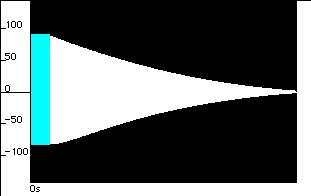 "Looking at the Minimoog's amplitude envelope (Fig. 1) reveals that even with the sustain set to minimum, there's about 20-30 milliseconds where the sound stays at maximum level before the decay begins. There is no way to eliminate this short period of full volume sustain; it's part of the Minimoog's characteristic sound. It's also what happens to percussive sounds when you clip, limit, or compress them."
"Looking at the Minimoog's amplitude envelope (Fig. 1) reveals that even with the sustain set to minimum, there's about 20-30 milliseconds where the sound stays at maximum level before the decay begins. There is no way to eliminate this short period of full volume sustain; it's part of the Minimoog's characteristic sound. It's also what happens to percussive sounds when you clip, limit, or compress them."Title link takes you there.
Eurorack Modular - New Flicrk Shot
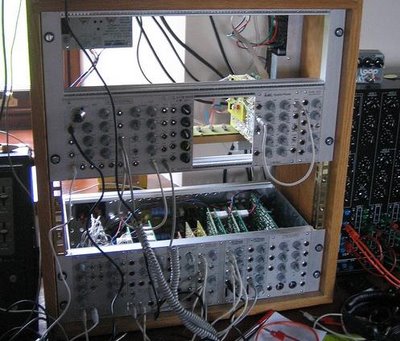 flickr by unrest. Title link takes you to a few more. Note Eurorack refers to the physical dimensions of the rack modules not the manufacturer.
flickr by unrest. Title link takes you to a few more. Note Eurorack refers to the physical dimensions of the rack modules not the manufacturer.
WEM Nightshade
via this auction
"Vintage WEM Nightshade analog synth form the '70.
This item is VERY RARE. Sonic Boom (Spacemen 3, EAR) tell me that only 180 was produced from wem. WEM is almost know for their amps or analog echo used by Pink Floyd in the '70. This synth is VERY FAT sounding!!! It is monophonic. 2 osilators with many sound options.... see the foto for spec. 220/110V. In pristine conditions with original cover and power cable (not pictured), full working but sold as is due to its age."
Thursday, April 27, 2006
Soviet Synthesizers Sample Collection
 Hmm... I had this one ready to go on 4/18, but I missed publishing it. Oh well... Here it goes. I'm not big on posting sample collections, but this one does look interesting. Title link takes you to SoundEngine.com's Soviet Synths page with sample links on the bottom. They have a sample disk of over 1000 samples of Soviet made synths. Check out the pdf for the synths used including images and details.
Hmm... I had this one ready to go on 4/18, but I missed publishing it. Oh well... Here it goes. I'm not big on posting sample collections, but this one does look interesting. Title link takes you to SoundEngine.com's Soviet Synths page with sample links on the bottom. They have a sample disk of over 1000 samples of Soviet made synths. Check out the pdf for the synths used including images and details."More than 600Mb of analog synthesizer samples are available - fat bass lines, warm pads, aggressive razor leads, smooth classic waveforms, space FX, sounds of noises and machines, percussion, original real time phrases and much more...Thanks to unique architecture and powerful resonant filters, Soviet-made synthesizers have inimitable color in their sound; you get a lot of cool stuff for creating killer patches!"
CDM Site Issues
If you've notice problems getting to Create Digital Music, here's why.
"Due to avoidable circumstances with Create Digital Music's web host,
1and1.com, CDM is currently inaccessible (and has been since about
11:30am yesterday, Eastern time). We are moving the site to an
upgraded server to restore service immediately, and will take measures
to make sure this doesn't happen again. Thanks for your patience."
The unofficial line: 1+1 screwed me over and took my site hostage,
moving it without warning to an "auxilliary server" that they knew
wouldn't handle the load so they could ransom out a more expensive
dedicated server account, even though my server logs suggest I was
using a fraction of my available bandwidth and there was no major
traffic spike yesterday.
I'm working now on rescuing the site, but that's the situation. You
can bet once my site is safely off 1+1's server, I'll have a thing or
two to say about webhosts; for now, I have to keep silent.
Peter"
"Due to avoidable circumstances with Create Digital Music's web host,
1and1.com, CDM is currently inaccessible (and has been since about
11:30am yesterday, Eastern time). We are moving the site to an
upgraded server to restore service immediately, and will take measures
to make sure this doesn't happen again. Thanks for your patience."
The unofficial line: 1+1 screwed me over and took my site hostage,
moving it without warning to an "auxilliary server" that they knew
wouldn't handle the load so they could ransom out a more expensive
dedicated server account, even though my server logs suggest I was
using a fraction of my available bandwidth and there was no major
traffic spike yesterday.
I'm working now on rescuing the site, but that's the situation. You
can bet once my site is safely off 1+1's server, I'll have a thing or
two to say about webhosts; for now, I have to keep silent.
Peter"
MEK #6 Arrives
 They are officially shipping. This is the first one I've heard of being delivered. It belongs to Jason Proctor. Title link takes you to more shots. Gorgeous under the Prophet VS. According to Jason, "the thing is cute beyond belief and sounds lovely. i thought it would cross over a lot with my VS, but the sonic character is different altogether."
They are officially shipping. This is the first one I've heard of being delivered. It belongs to Jason Proctor. Title link takes you to more shots. Gorgeous under the Prophet VS. According to Jason, "the thing is cute beyond belief and sounds lovely. i thought it would cross over a lot with my VS, but the sonic character is different altogether."
Midiweb.de
 Bookmarking this one for my own reference. Title link takes you there. Midiweb.de makes the following software editors:
Bookmarking this one for my own reference. Title link takes you there. Midiweb.de makes the following software editors:Korg EM-1 Editor (pictured)
Tyros - Magic Voice Generator
XG - Wizard
XG - Gold
via Moogulator.
Mark Pulver's Time - The Olde Days
Click here for a 7.25M mp3 Mark Pulver sent to AH. Below are the notes on the track also sent to the list after quite a few people asked. I asked Mark if I could put this up and he say yes. It's a fascinating piece. Thanks Mark!
"The track was done in 1979 (possibly early 1980) and is called "Time". The setup was the SIUC (Southern Illinois University - Carbondale) music lab - which is sadly no longer there.
The lab was "cool" in the sense of what a lot of us olde tymers here would consider cool. Homebrew quad system, _PLATE_ reverb, modified Hammond tank reverb, upright piano with the back torn off for access to the harp ("prepared piano" for you olde folkes), an AKS, a bunch of tape decks, microphones, patch panels and... a nicely outfitted Moog modular. It was a System 55 with an extra top cabinet, two voice keyboard and a ribbon.
ahhh... my first love. :)
When I showed up, I brought along my (then brand new!) Rev 2 P5 and a MXR digital delay. The MXR was the first digital piece in the lab. :)
Anyway.. "Time" is around 25 tracks of stuff... noises, pads, pans, textures, etc. About 80% of what you hear as polyphonic is - it's the P5. The other 20% is multitracking from the Moog, or a single big honkin' multi-oscillator/multi-output patch.
"highlights" (ewww!) might include the constant atmosphere that's walking around left & right sides. That's the Moog driven by the 960. A killer combo that I DEARLY miss - the aural effect of the sequence changing is actually just from starting/stopping/triggering the 960 at different points or with different filter accents, speeds, etc. It's the same sequence.
There are a couple of big poly slides into oblivion - that's an old trick on the P5 (set unison, set glide, hold a note, kill unison, hit a chord - I think that's how it worked).
The ambience is generally the hacked Hammond tank, though the MXR is in there as well, usually _after_ the tank so that you get the smear.
Compression is courtesy of analog tape. The levels were pretty hot during some of the "tracks"... saturation is king. Digital today can't really touch something like this.
The piece used to be longer - about 11 minutes. I dunno that I still have that version. The front end was a bunch of babble over noises... nothing really exciting.
-------- start of typing while listening
The "Pink Floyd" sounding leads are all P5... The chordal undertone is P5. The airyness is courtesy of the Moog's fixed filter - VERY underutilized module. The "noise sparkling" that flutters around on top of the ping-pong sequence is P5.
If you can't tell, there was no "composition" to the piece. It's all vamping. I don't really remember where I started - if I had to guess it would be the P5 poly work... that was what I was into during that time.
The rushing and noise swirls to the end are both the Moog and P5. If it sounds deep and "OMG!" that's the Moog. That ringing tone is all Moog.
One thing about the bouncing around at the end and at a couple of spots in the middle... If you listen to it on speakers, and put yourself in the point of an equilateral triangle (based on the distance between the speakers) then you should be able to pick out a hidden 3rd channel. Along this time I was doing some work with burying a track by flipping it's phase across the L & R channels. if the L/R level is the same, and if you're at the point, then the track disappears. Move your head a bit and it'll show up.
Yes, this has been done a lot, but remember - this was 1979. :)
Anyway.. It's nothing big, but it's in there. I have NO idea how compressing this into MP3 would whack this around.
Oh! Love the tape noise at the end? There're a LOT of bounces in here with no noise reduction.
---- end of typing while listening ----
I think that's about it. Basically, the gear was minimal, it was just the right gear for the track - and the time. Putting this to tape helped a LOT, there's no way it would sound this "warm" (oh Gawd, not THAT word!) today.
fwiw, and I've said this before, THIS marks the time in my head that I'd love to get back to musically. I've never had more fun or been more satisfied than during this time.
... but, I've never been able to find it again. sigh.
Thanks for listening - and thanks for the comments!"
"The track was done in 1979 (possibly early 1980) and is called "Time". The setup was the SIUC (Southern Illinois University - Carbondale) music lab - which is sadly no longer there.
The lab was "cool" in the sense of what a lot of us olde tymers here would consider cool. Homebrew quad system, _PLATE_ reverb, modified Hammond tank reverb, upright piano with the back torn off for access to the harp ("prepared piano" for you olde folkes), an AKS, a bunch of tape decks, microphones, patch panels and... a nicely outfitted Moog modular. It was a System 55 with an extra top cabinet, two voice keyboard and a ribbon.
ahhh... my first love. :)
When I showed up, I brought along my (then brand new!) Rev 2 P5 and a MXR digital delay. The MXR was the first digital piece in the lab. :)
Anyway.. "Time" is around 25 tracks of stuff... noises, pads, pans, textures, etc. About 80% of what you hear as polyphonic is - it's the P5. The other 20% is multitracking from the Moog, or a single big honkin' multi-oscillator/multi-output patch.
"highlights" (ewww!) might include the constant atmosphere that's walking around left & right sides. That's the Moog driven by the 960. A killer combo that I DEARLY miss - the aural effect of the sequence changing is actually just from starting/stopping/triggering the 960 at different points or with different filter accents, speeds, etc. It's the same sequence.
There are a couple of big poly slides into oblivion - that's an old trick on the P5 (set unison, set glide, hold a note, kill unison, hit a chord - I think that's how it worked).
The ambience is generally the hacked Hammond tank, though the MXR is in there as well, usually _after_ the tank so that you get the smear.
Compression is courtesy of analog tape. The levels were pretty hot during some of the "tracks"... saturation is king. Digital today can't really touch something like this.
The piece used to be longer - about 11 minutes. I dunno that I still have that version. The front end was a bunch of babble over noises... nothing really exciting.
-------- start of typing while listening
The "Pink Floyd" sounding leads are all P5... The chordal undertone is P5. The airyness is courtesy of the Moog's fixed filter - VERY underutilized module. The "noise sparkling" that flutters around on top of the ping-pong sequence is P5.
If you can't tell, there was no "composition" to the piece. It's all vamping. I don't really remember where I started - if I had to guess it would be the P5 poly work... that was what I was into during that time.
The rushing and noise swirls to the end are both the Moog and P5. If it sounds deep and "OMG!" that's the Moog. That ringing tone is all Moog.
One thing about the bouncing around at the end and at a couple of spots in the middle... If you listen to it on speakers, and put yourself in the point of an equilateral triangle (based on the distance between the speakers) then you should be able to pick out a hidden 3rd channel. Along this time I was doing some work with burying a track by flipping it's phase across the L & R channels. if the L/R level is the same, and if you're at the point, then the track disappears. Move your head a bit and it'll show up.
Yes, this has been done a lot, but remember - this was 1979. :)
Anyway.. It's nothing big, but it's in there. I have NO idea how compressing this into MP3 would whack this around.
Oh! Love the tape noise at the end? There're a LOT of bounces in here with no noise reduction.
---- end of typing while listening ----
I think that's about it. Basically, the gear was minimal, it was just the right gear for the track - and the time. Putting this to tape helped a LOT, there's no way it would sound this "warm" (oh Gawd, not THAT word!) today.
fwiw, and I've said this before, THIS marks the time in my head that I'd love to get back to musically. I've never had more fun or been more satisfied than during this time.
... but, I've never been able to find it again. sigh.
Thanks for listening - and thanks for the comments!"
Freeez Keytar Action
 Some keytar action for you. Title link takes you there.
Some keytar action for you. Title link takes you there.And then there is this. No synth connection other other than a song of the same name with a lead singer that looks a lot like David Lee Roth. BTW, I always mixed these two songs up. At one point I actually questioned if they were the same song, just redone from the "David Lee Roth" version to the Freeze version. I never bothered to look them up, becaue I really didn't care other than the "hey, I thought I heard this before and it sounded different." But now I know. Odd that one of my life's little bizarre and forgotten mysteries is rediscovered and answered on a synth forum. I actually had that little moment of clarity, "ah.. so that's what it was..."
Via this VSE post.
BugBrand
 I thought I had a proper post on BugBrand, but apparently not. I had this Weevil post, followed by this. Only Weevils! So here you go, a proper BugBrand post. Title link takes you there. Via Analog Industries.
I thought I had a proper post on BugBrand, but apparently not. I had this Weevil post, followed by this. Only Weevils! So here you go, a proper BugBrand post. Title link takes you there. Via Analog Industries.
Wednesday, April 26, 2006
Thomas Dolby Interview
Title link takes you there.
"BD: What is your take on analog nostalgia and the resurgence of homebrew synths? People are taking the SID chips out of Commodore 64 computers and wreaking havoc; Products like the SID Station, TB303 cloning, x0xb0x, countless others...
TMDR: Yeah, I mean, I'm all for it, you know, I think it's fantastic the level to which electronic music has really sort of permeated. When I started out in the late 70s there were only really a handful of us doing it. There was myself and Throbbing Gristle and Cabaret Voltaire, and a few other people. Synthesizers were still something of a rarity. And my generation were inspired by the ones that went before us; the Fripps and the Enos of the world and Kraftwerk, obviously, people like that. But we were developing this stuff in parallel to punk rock and punk of course stole the headlines. It was only really in the 80's when bands like The Human League and New Order and Depeche Mode starting having bonafide chart hits that the electronic music movement really sort of went mainstream. And then the prices started to come down, you saw personal computers getting in there, and suddenly my $120,000 Fairlight was looking like a useless antique. "
"BD: What is your take on analog nostalgia and the resurgence of homebrew synths? People are taking the SID chips out of Commodore 64 computers and wreaking havoc; Products like the SID Station, TB303 cloning, x0xb0x, countless others...
TMDR: Yeah, I mean, I'm all for it, you know, I think it's fantastic the level to which electronic music has really sort of permeated. When I started out in the late 70s there were only really a handful of us doing it. There was myself and Throbbing Gristle and Cabaret Voltaire, and a few other people. Synthesizers were still something of a rarity. And my generation were inspired by the ones that went before us; the Fripps and the Enos of the world and Kraftwerk, obviously, people like that. But we were developing this stuff in parallel to punk rock and punk of course stole the headlines. It was only really in the 80's when bands like The Human League and New Order and Depeche Mode starting having bonafide chart hits that the electronic music movement really sort of went mainstream. And then the prices started to come down, you saw personal computers getting in there, and suddenly my $120,000 Fairlight was looking like a useless antique. "
Selling Moog in Taco Bell
 "[I]n music stores throughout the country, young kids bought the Minimoog because of a former evangelist David van Koevering, whom [Robert] Moog had enlisted to sell the new product.
"[I]n music stores throughout the country, young kids bought the Minimoog because of a former evangelist David van Koevering, whom [Robert] Moog had enlisted to sell the new product.Like a traveling medicine show, Van Koevering moved thousands of Minimoogs by using innovative marketing techniques. In Florida, he hooked up with Taco Bell, handing out free coupons to the restaurant, and then showing up later in the evening to play to diners. He promoted the "Island of Electronicus," an artificial land mass connected by a causeway to the Florida coast, where a Moog concert was scheduled. The radio ads announced, "Where is the Moog synthesizer? It's here now ... to stimulate your feelings, thought, and your love for your fellow man."
Title link takes you to more. Via Music Thing.
Melissa's
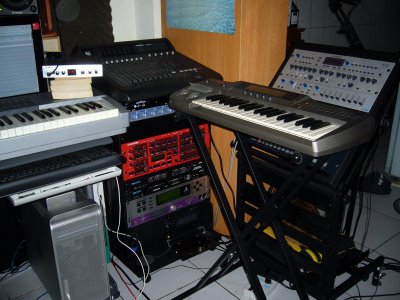 Melissa sent me a link to her website. I saw a cat so I'm putting up a post. : ) Title link takes you there. BTW, the cat is in this shot. Click it for a bigger image.
Melissa sent me a link to her website. I saw a cat so I'm putting up a post. : ) Title link takes you there. BTW, the cat is in this shot. Click it for a bigger image.
AHNE 2006 This Saturday - Hooowl!!!!
 I've already put up a couple of posts on AHNE 2006. Thought I'd put up one last one as it's this coming Saturday, 4/29. Wish I could be there, but I'm stuck on the west coast. : (
I've already put up a couple of posts on AHNE 2006. Thought I'd put up one last one as it's this coming Saturday, 4/29. Wish I could be there, but I'm stuck on the west coast. : ( Here's a shot from last years get-together. Hmm... That's one funny looking cat. Title link takes you to more info including links to images from last year's get together.
SN76477 Analog Synth on Get LoFi
Surge

Title link takes you there. Check out each demo at the bottom of the page. This one sounds really good. Via Moogulator.
Specifications (v1.1.0):
General
Synthesis method: Subtractive hybrid
Each patch contain two 'scenes' which are seperate instances of the enitre synthesis engine (except effects) that can be used for layering or split patches.
Category based patch-browser that is fast to use
Future proof, comes as both a 32 & 64-bit VST plugin
Factory sounds
681 patches
157 wavetables
Oscillators
3 oscillators/voice
5 versatile oscillator algorithms: Classic, Sinus, Wavetable, S/H Noise and Audio-input
The classic oscillator is a morphable pulse/saw/dualsaw oscillator with a sub-oscillator and self-sync.
Most algorithms (all except sinus and audio-input) offer up to 16-voice unison at the oscillator level.
Oscillator FM/ringmodulation
All oscillator algorithms are band-limited yet they still cover the entire audible spectrum.
Noise generator with variable spectrum
Filterblock
Two filter-units with arrangeable in 7 different configurations
Feedback loop
Available filter-algorithms: LP12, LP24, LP24L (ladder filter with 1-4 poles), HP12, HP24, BP, Notch, Comb (4 modes), S&H
Waveshaper (5 shapes)
Modulation
12 LFO-units available to each voice (6 are running on each voice and 6 are shared for the scene)
DAHDSR envelope generators on every LFO-unit
7 deformable LFO-waveforms + 1 drawable/stepsequencer waveform
LFO1 allows envelope retriggering when used as stepsequencer
Extremely fast and flexible modulation routing. Almost every continuous parameter can be modulated.
Effects
8 effect units arranged as 2 inserts/scene, 2 sends and 2 master effects
9 top-quality algorithms: Delay, Reverb, Chorus, Phaser, EQ, Distortion, Conditioner (EQ, stereo-image control & limiter), Rotary speaker, Frequency shifter
System Requirements
A computer running Windows 2000/2003/XP (32/64-bit) or newer
The computer's CPU must support the SSE instruction set. This is supported by Intel Pentium 3/4/M and AMD Athlon XP/64 (and newer) processors.
A VST-compatible Host application
An x64-compatible CPU, OS and Host is required to use the 64-bit version
Morton Subotnik on Chroniques de la Mao
 I knew he had four hands. Title link takes you to the post with more shots and some French for you lucky French readers. I'm starting to wish I took French instead of Spanish...
I knew he had four hands. Title link takes you to the post with more shots and some French for you lucky French readers. I'm starting to wish I took French instead of Spanish...
Tuesday, April 25, 2006
Mystery Synth on SubtleNoiseMaker

Click here for a guess the synth post on Subtle Noise Maker. You are looking at a custom cased synth from the 70s. There are samples on the site.
Update: answer is in the comments section of this post.
MEK Video via GearWire
 Title link takes you there.
Title link takes you there.Update via Duvalle in the comments:
"if you use this link:
http://www.gearwire.com/mov/
you will find more then 50 movies about many other namm 2006 highlights ... "
Off to go check em out. I'll try and spare you all 50 new posts. : )
Apocolypse Moog
 Title link takes you to a post on VSE discussing the synths used for the soundtrack of Apocolypse now. Check out this Moog modular housed in plexi-glass. I missed this one on VSE. Via Music Thing.
Title link takes you to a post on VSE discussing the synths used for the soundtrack of Apocolypse now. Check out this Moog modular housed in plexi-glass. I missed this one on VSE. Via Music Thing.
Fairlight Keyboard Signing on DVDBorn
Updates on Cyndustries
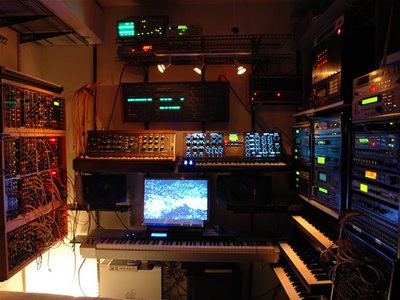
Make sure to check out the gallery.
"Howdy!
A section of new Links have been added to the bottom of the Zeroscillator Pages called "Further Reading on FM Synthesis", (we welcome any other recommended Links on the subject)...
Also, New Pictures have been posted to the Cynthia Customs Album here, as well as new pictures have been added to the Gallery Pages in the GOODIES Section of the Cyndustries Website
Best Wishes!
Cynthia
http://www.cyndustries.com/goodies.cfm"
NIN Buchla 259 VCO on Buzzclick
Multimode Roland 100m 121 Filter
 I totally missed this post on Moogulator. What's off about this image? Take a look at this shot. Yep, the multimode filter. Moogulator tracked down Synth Ollie and found out that this unit actaully has an Oberheim SEM pcbn inside. Nice.
I totally missed this post on Moogulator. What's off about this image? Take a look at this shot. Yep, the multimode filter. Moogulator tracked down Synth Ollie and found out that this unit actaully has an Oberheim SEM pcbn inside. Nice.
More Dolby Synth P*rn
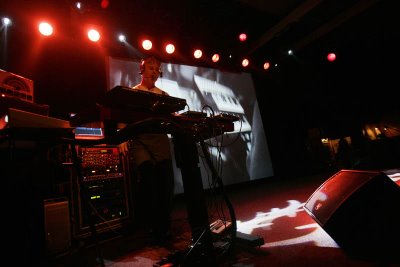 Title link takes you there. Love how he projects what he's playing on the screen for the audience to see.
Title link takes you there. Love how he projects what he's playing on the screen for the audience to see.
Bent 2006 Via Inverse Room
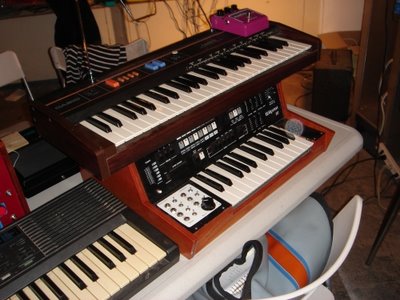 Title link takes you shots of this years Bent 2006 in NYC. Inverse Room's band The Bemus Point played Friday.
Title link takes you shots of this years Bent 2006 in NYC. Inverse Room's band The Bemus Point played Friday. "It was awesome--nice crowd, lots of smart, creative people, and was that Moby wandering through the crowd? Here's a few pics...I tried to get some performance shots of The Circuit Bending Orchestra and Mystery Circuits (that's Mike Walters' band, the walkman mellotron dude), but it was too dark.
This is a terrific festival, well organized and great fun. Long may it reign.
Best,
Inverse Room"
Image is Mike Walters' gear, of Mysterycircuits.com.
1934 Clough Brengle Beat Frequency Oscillator
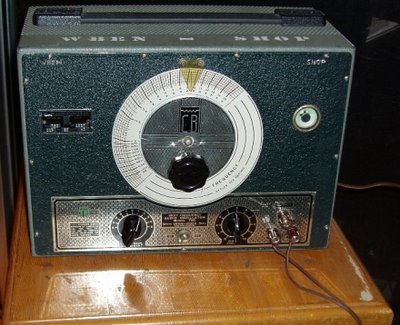 Title link takes you to three shots sent my way via Brian Comnes.
Title link takes you to three shots sent my way via Brian Comnes."Here are 3 shots
The 1934 Clough Brengle beat frequency oscilator by itself, note the the WBEN Shop label, WBEN is Buffalo NY radio , kinda cool tattoo.
Then 2 shots of it in my rig....output is being sent to an Alesis Bitrman then gated by the Korg ER-1, the bit reduction artifacts gets real interesting between 12Khz and 15Khz.
The rest of the rig is a DSI Evolver, Emu XL-1, Oberheim OB-3 and Ableton live.
Sorry no T-shirt or cat in the shot"
Shucks, no cat. ; ) BTW, Brian is referring to the Matrixsynth T (there are only three of us in the world with them at the moment; kinda cool in a way).
LABELS/MORE:
Ableton,
Alesis,
DSI,
E-mu,
Korg,
Matrixsynth,
Oberheim,
Synth Bling,
Synth Clothes,
Synth Ts
sf6 - New Flickr Shot
JMJ Studio on YouTube
 Ok, I didn't think I'd be putting up another JMJ on YouTube post so soon, but Synthtopia posted this one with a nice walkthrough of his studio. It's a must see. The funny thing is he's sitting there with the interviewer on his couch, when he gets up and takes him for a mini tour of the studio. What's funny is that the studio is filled with synths - Fairlight, Synthi, Arp 2600, modulars, and... this guy sitting behind a mixer. My first thought was the guy must be a permanent fixture in the studio. Over 100k worth of synths are in that room so why not? Just buy a guy and put him in your home studio. "Don't touch the synths! Only the mixer..." : ) Joke aside, anyone know who he is?
Ok, I didn't think I'd be putting up another JMJ on YouTube post so soon, but Synthtopia posted this one with a nice walkthrough of his studio. It's a must see. The funny thing is he's sitting there with the interviewer on his couch, when he gets up and takes him for a mini tour of the studio. What's funny is that the studio is filled with synths - Fairlight, Synthi, Arp 2600, modulars, and... this guy sitting behind a mixer. My first thought was the guy must be a permanent fixture in the studio. Over 100k worth of synths are in that room so why not? Just buy a guy and put him in your home studio. "Don't touch the synths! Only the mixer..." : ) Joke aside, anyone know who he is?
Monday, April 24, 2006
Tara Busch, Two Moogerfoogers and a Pro One
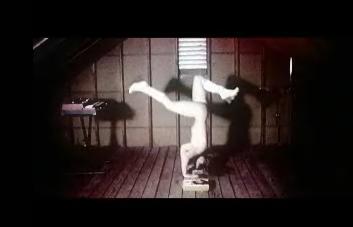
 Title link takes you to Tara Busch's MySpace site with a couple of videos. Check out the kit list. I'm guessing that's the Vox Jaguar in the nudie shot. Also worth noting is band member Mike Walters of Mystery Circuits. Via Music Thing.
Title link takes you to Tara Busch's MySpace site with a couple of videos. Check out the kit list. I'm guessing that's the Vox Jaguar in the nudie shot. Also worth noting is band member Mike Walters of Mystery Circuits. Via Music Thing.
PSP Rhythm 5.0 Released
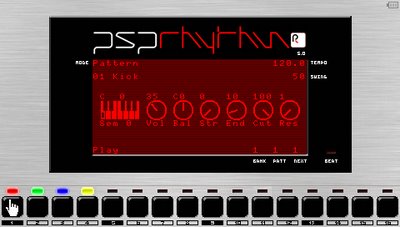
For the Sony PSP. Make sure to check out the demo mp3 below.
"PSP Rhythm 5.0 is a homebrew music application which has 4 distinct features. The first is the sample sequencer which enables you to arrange standard .wav file samples into beats, rhythms, and melodies in pattern format. Sample control includes FLAMS, REVERSE, PITCH, VOLUME, BALANCE, START TIME, and END TIME. These parameters can be stored with different settings on each step providing you the ability to make very complex music. The second feature is a realtime Roland TB-303 bass line style synthesizer which can be played along with the sample sequencer. The bass line synth has all of the original synthesizer's controls, such as ACCENT, SLIDE , CUTOFF, and RESONANCE . The third feature is the NEW EFFECTS UNITS which include DISTORTION, SLICER, DELAY, LOWPASS FILTER, and MONOMODE. These effects can be combined for some extensive audio manipulation. The lowpass filter is special because it can be controlled per sound via PATTERN mode which essentially gives you control of up to 15 separate sample filters! The final feature is a song mixer where you can chain up to 512 patterns together along with mixing each individual sound volume per song step (much like a mixing desk). Once you have created your audio masterpiece, you can render it to a .wav file for listening or outside processing. PSP RHYTHM 5.0 has grown to be a full audio production suite in the palm of your hand.
Demo Song
http://www.psprhythm.com/rhythm5.0.mp3
Windows Installer
http://www.psprhythm.com/Rhythm.zip
Manual Installer
http://www.psprhythm.com/Rhythm5.0.zip
Website
http://www.psprhythm.com"
Racked Wasp

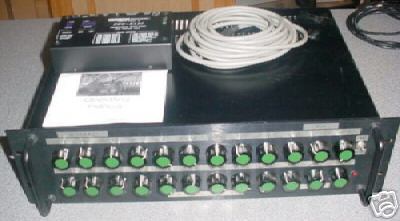
Shots and details pulled via this auction
This one sent my way via Tom of Music Thing. Thanks Tom!
"Wasp Rack Sound Module with Kenton Pro Kadi MIDI Trigger
Unique Wasp Rack Sound Module. All the controls and workings of the EDP Wasp built in to a 2 U Rack Housed unit. Comes complete with Kenton Pro Kadi Multi Mode MID Trigger Unit, so the 2 1/2 Wasp Keyboard octave range can be played with any Midi Keyboard.
The EDP Wasp was released in the UK in 1978 as a budget monosynth: "One of the biggest advances in synthesiser design - an ultra low cost, high performance instrument" and was one of the most unusual looking modern synthesisers. The Wasp was built in garish black and yellow plastic with a flat yellow laminated carboard 'keyless' two octave keyboard. The instrument weighed no more than a couple of pounds. The sound from the instrument came from two digital VCO running through an analogue VCF which gave the instrument a distinctive and powerful sound belying its awkward appearance. The Wasp was designed by the british designer Chris Hugget who was also responsible for the "Oscar" Synthesiser.
A Wasp in a Rack, what a novel idea!!"
Deepsonic

Click here for Deepsonic. Scroll down and click on the Update :Hardware: link when you get there for various synth shots and samples. These are worth checking out.
Moog Source Membrane Switch Cure
 Another via Moogulator. "Julie Landry contacted me about her Moog Source. When she bought it, most of the membrane switches were bad. She asked me if I could rewire it with real switches. Reluctantly, I finally said yes. One year later, she got her synthesizer back with a completely new switch panel with real stinkin buttons, and blue lights."
Another via Moogulator. "Julie Landry contacted me about her Moog Source. When she bought it, most of the membrane switches were bad. She asked me if I could rewire it with real switches. Reluctantly, I finally said yes. One year later, she got her synthesizer back with a completely new switch panel with real stinkin buttons, and blue lights."
PREVIOUS PAGE
NEXT PAGE
HOME













© Matrixsynth - All posts are presented here for informative, historical and educative purposes as applicable within fair use.
MATRIXSYNTH is supported by affiliate links that use cookies to track clickthroughs and sales. See the privacy policy for details.
MATRIXSYNTH - EVERYTHING SYNTH













© Matrixsynth - All posts are presented here for informative, historical and educative purposes as applicable within fair use.
MATRIXSYNTH is supported by affiliate links that use cookies to track clickthroughs and sales. See the privacy policy for details.
MATRIXSYNTH - EVERYTHING SYNTH







